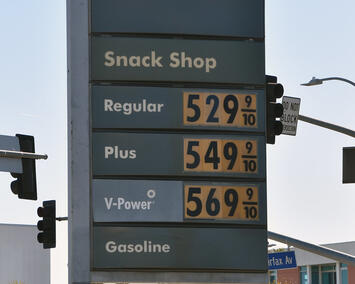
While no Americans are happy about the “special military operation” in Ukraine, transit agencies and advocates are positively giddy about the effect of that operation on gas prices. Despite all their bombast about light rail, bus-rapid transit, and other expensive programs, they know that, historically, the only thing that really boosts transit ridership is rising fuel prices.
The problem with that is that the forces against transit are much stronger than they were before the pandemic, when more than 7 million people a day marched to jobs in big city downtowns. That was transit’s target market, and now it has all but evaporated.
First, downtown businesses are closing or moving to other parts of the cities, chased away not just by the pandemic but by rising downtown crime. Second, many people who do return to downtown jobs are working there only three days a week and working from home the other two days — and not just high-tech workers. Third, people who work at home part time will need larger homes and, since they will commute fewer times a week, can move further away from their workplaces, putting them out of range of transit systems. Finally, people remain uneasy about jamming themselves into crowded containers, both because of infectious diseases and because of crime.
The bottom line is that downtowns will probably only host about half as many workers on any given day as before the pandemic, and many of them won’t be living in places where they have access to transit. Combine this with the effects of reduced congestion and transit loses any advantages it once had for most downtown workers. For people who don’t work downtown, transit remains as unattractive as ever.
On the other hand, the benefits to transit of higher gasoline prices are pretty small. While reports of $7 a gallon gasoline are scary, the reality is that — as of this writing — the nationwide average for regular gasoline hasn’t topped $4.35. Adjusted for inflation, that’s less than the price of gasoline in 2012, when prices briefly hit $3.90 a gallon or $4.82 in today’s dollars. Between 1999 and 2011, inflation-adjusted gas prices grew by 170 percent, yet transit ridership rose by only 12 percent. Such a small increase isn’t enough to offset more than a small portion of the declines caused by the other factors listed above.
Transportation modeler Charles Komonoff observes that a 50 percent rise in fuel prices leads to a short-term drop in driving of just 4 percent. Most of that doesn’t translate to increased transit ridership; instead, it is accounted for by people taking fewer trips or driving the more fuel-efficient vehicles in their family fleets. The long-run effects are a little greater, but the biggest effect is that people save energy by buying more fuel-efficient cars. That doesn’t translate to more transit ridership either.
Before the current rise in fuel prices, I predicted that transit would never recover more than 75 percent of its pre-pandemic ridership, and I suspect that was generous. Fuel prices are high only because of geopolitical events, not due to actual shortages of fuel. That means prices won’t remain high forever. Meanwhile, tt will take many months or even years for transit to even reach that 75 percent, and by that time fuel prices may come back down. While high gas prices may help transit agencies a little, I doubt that it will be enough to nudge ridership above that 75 percent.
This piece first appeared on The Antiplanner.
Randal O’Toole, the Antiplanner, is a policy analyst with nearly 50 years of experience reviewing transportation and land-use plans and the author of The Best-Laid Plans: How Government Planning Harms Your Quality of Life, Your Pocketbook, and Your Future.
Photo: Chris Yarzab, via Flickr under CC 2.0 License.












